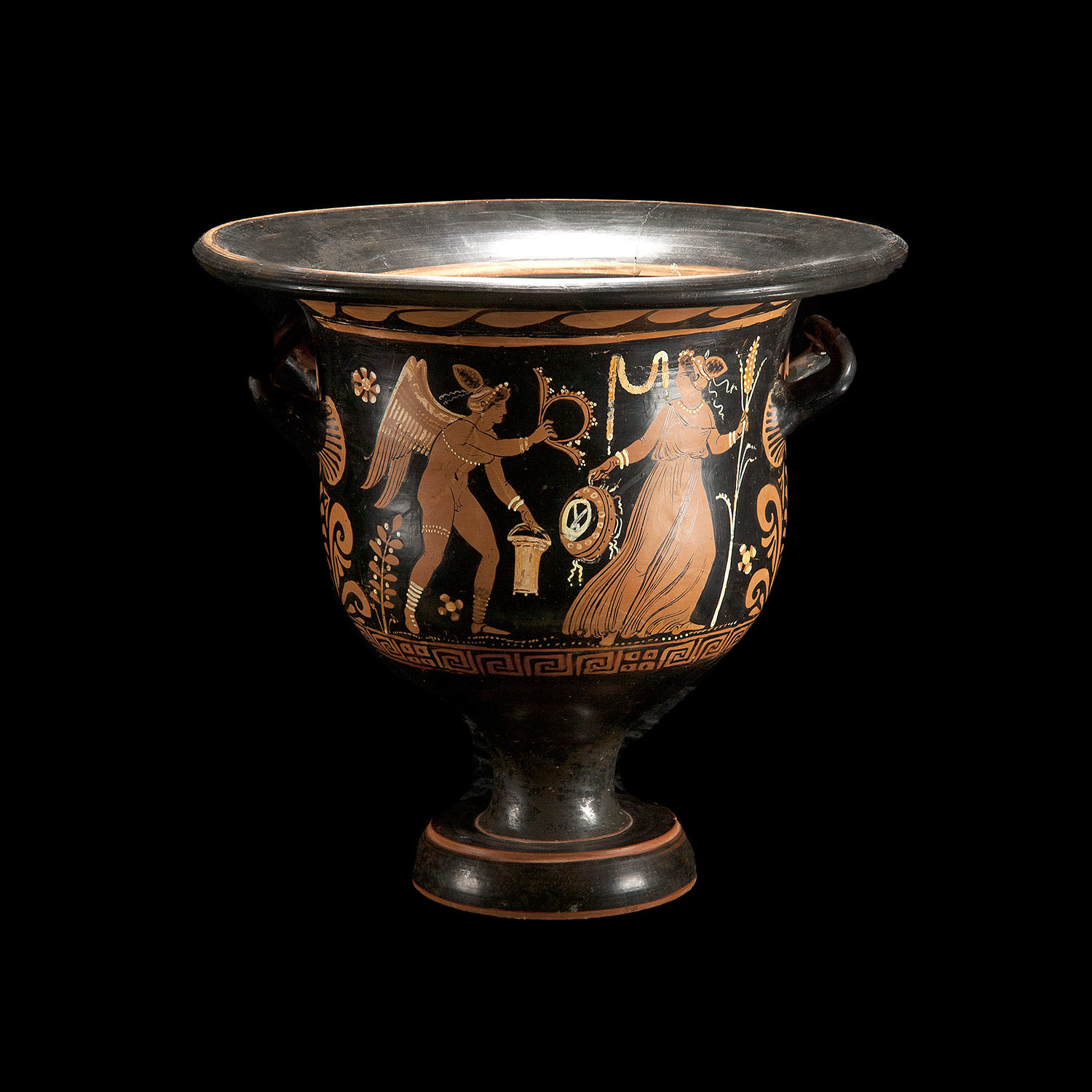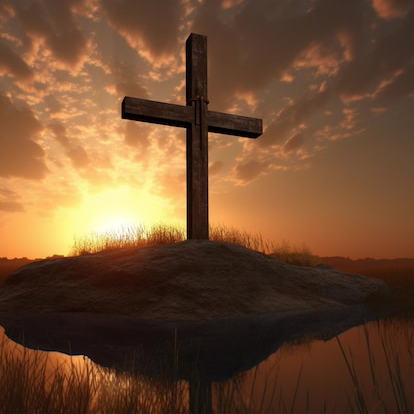Sons of God
Seth didn't have a son until 235 years after creation, and his son didn't have a son until 325 years after creation (Genesis 5:3,6,9). Where did these sons come from? They couldn't have been sons of Seth, because these marriages took place when men began to multiply-in the very beginning of the race before Seth had sons of marriageable age. The term "sons of God" proves they were the product of God, not Seth. They were the fallen angels of 1 Peter 3:19; 2 Peter 2:4; Jude 1:6-7. See the Septuagint; Josephus, Antiquities Book 1, 3:1; Ante-Nicene Fathers, Vol. VIII, p. 273; and Giants and the Sons of God.
—Dake's Topics
Proofs that Giants Were the Sons of Angels:
1. The fact that giants have lived on earth is clearly stated in Scripture. The Hebrew nephil (HSN-<H5303>) means "giant" or "tyrant" (Gen. 6:4; Num. 13:33). The men of Israel were as grasshoppers compared to them (Num. 13:33). The Hebrew gibbowr (HSN-<H1368>) is also translated "giant," meaning powerful, giant, mighty, or strong man (Job 16:14). To say these original words refer to their degree of wickedness instead of bodily size is a mistake.
The Anakims were a great and tall people (Dt. 1:28; 2:10-11,21; 9:2; Josh. 11:21-22; 14:12-14). Anak himself was a giant (Num. 13:33). If all Anakims were as big, we can be assured other giants were also. The land of Ammon was "a land of giants," for "giants dwelt therein in old time" (Dt. 2:19-20). The Emims were also "great, and many, and tall, as the Anakims" (Dt. 2:10-11). The same was said of the Zamzummims who formerly inhabited the land of Ammon (Dt. 2:19-21). Og, king of Bashan, is described as a giant whose iron bedstead was thirteen and a half feet long, and six feet wide. This is not a measurement of wickedness, but of a material bed for a giant body measuring nearly thirteen feet tall (Dt. 3:11; Josh. 12:4; 13:12). Bashan is called "the land of the giants" (Dt. 3:13).
A "valley of the giants" is mentioned in Josh. 15:8; 18:16. This is the valley of Rephaim, the name of another branch of the giant races mentioned in Scripture (Gen. 14:5; 15:20; 2Sam. 5:18,22; 23:13; 1Chr. 11:15; 14:9; Isa. 17:5). The Rephaims were well-known giants, but unfortunately, instead of retaining their proper name in Scripture, the translators used dead (Job 26:5; Ps. 88:10; Prov. 2:18; 9:18; 21:16; Isa. 14:8; 26:19); and deceased (Isa. 26:14). It should have been a proper name in all these places, as it is ten times otherwise. See notes on these passages which prove that giant bodies are referred to instead of great wickedness.
Rephaim is translated "giant" in Dt. 2:11,20; 3:11,13; Josh. 12:4; 13:12; 15:8; 18:16; 2Sam. 21:16,18,20,22; 1Chr. 20:4,6,8. The phrase "remnant of the giants" in Dt. 3:11; Josh. 12:4; 13:12 should be "remnant of the Rephaims," becaause there were many nations of giants other than the Rephaims who filled the whole country trying to contest God's claim on the promised land. They are listed as Kenites, Kenizzites, Kadmonites, Hittites, Perizzites, Rephaims, Amorites, Canaanites, Girgashites, Jebusites, Hivites, Anakims, Emims, Horims, Avims, Zamzummims, Caphtorims, and Nephilims (Gen. 6:4; 14:5-6; 15:19-21; Ex. 3:8,17; 23:23; Dt. 2:10-12,20-23; 3:11-13; 7:1; 20:17; Josh. 12:4-8; 13:3; 15:8; 17:15; 18:16). Og was of the remnant of Rephaims, not the remnant of all other giant nations (Dt. 3:11; Josh. 12:4; 13:12).
All these giant nations came from a union of the sons of God (fallen angels) and daughters of men after the flood. Beings of great stature, some of them even had six fingers on each hand and six toes on each foot and carried spears weighing from 10 to 25 pounds (2Sam. 21:16-22; 1Chr. 20:4-8). Goliath, whom David slew, wore a coat of armor weighing 196 pounds and was nine feet and nine inches tall (1Sam. 17:4-6). The pyramids of Egypt, the giant cities of Bashan and other huge monuments of construction may remain a mystery until they are accepted as the result of the labor and skill of giants.
The revelation we have of giants in Scripture gives us a true picture of what Greek mythology tries in vain to give. Mythology is but the outgrowth of traditions, memories, and legends telling of the acts of supernatural fathers and their giant offspring -- the perversion and corruption in transmission of actual facts concerning these mighty beings. The fact that giants were partly of supernatural origin made it easy for human beings to regard them as gods.
2. The fact that the Rephaim have no resurrection (Isa. 26:14) proves the reality of giants and that they were not ordinary men. All ordinary men are to be resurrected (Jn. 5:28-29); therefore, giants must be a different class from pure Adamites. Isaiah makes it clear that the dead (Hebrew: Repha'iym (HSN-<H7497>)) are now in hell (Isa. 14:9). Solomon confirms this in Prov. 2:18; 9:18; 21:16 where the Hebrew word for dead is Rephaim. See notes, Isa. 26:14,19.
3. The fact that giants came only from a union of sons of God and daughters of men proves that their fathers were not ordinary men of Adamite stock. No such monstrosities have been produced from the union of any ordinary man and woman, regardless of the righteousness of the father or the wickedness of the mother. Many converted men who are sons of God in the sense of adoption and righteousness through Christ have been married to unconverted women, and no offspring the size of Biblical giants has ever resulted from these unions. If, as some teach, giants were born of such unions both before and after the flood, then why do not such marriages produce that kind of offspring today? Why did this happen in every case then and never today?
4. God's law of reproduction from the beginning has been everything after its own kind. It was not possible then that giants could be produced by men and women of ordinary size (Gen. 1:11-12,21,24-25; 8:19). It took a supernatural element, the purpose and power of Satan and his angels, to make human offspring of such proportion. After giants came into being, they then produced others of like size instead of ordinary sized men (Num. 13:33; 2Sam. 21:16,18,20,22; 1Chr. 20:4-8).
5. Not only is it unscriptural but unhistorical to teach that giants came from the union of ordinary men and women. The great question has been: Where did giants get their start? Gen. 6:4 makes it clear -- from a union of the sons of God and daughters of men. If the sons of God were ordinary men in the same sense that the daughters of men were ordinary women, then we must conclude four things:
(1) Ungodly women have the power to produce such monsters if married to godly men.
(2) Godly men have the power to produce giants when married to ungodly women.
(3) A mixture of godliness and wickedness produces giants.
(4) Extreme wickedness on the part of either parent will produce giant offspring.
All four conclusions are wrong, however, as proven every day by the ordinary offspring of wicked and godly parents. Thus, the theory that giants came from the marriage of Seth's sons with Cain's daughters is disproved.
6. The sons of God could not have been the sons of Seth or other godly men for the following seven reasons:
(1) There were no men godly enough to be saved during the Antediluvian Age except Abel (Gen. 4:4; Heb. 11:4), Enoch (Gen. 5:21-24; Heb. 11:5), and Noah (Gen. 6:8; 7:1; Heb. 11:7), as far as Scripture is concerned. Shall we conclude that these three men were the sons of God who married the daughters of Cain and produced races of giants in the earth in those days before the flood (Gen. 6:4)? We have no record of any marriage or offspring of Abel before he was murdered. Regarding Enoch, are we to believe that Methuselah and his other children were the giants? Are we to believe that Noah's three sons -- Shem, Ham, and Japheth -- were giants? If so, where is our authority for this? Had this been true, there would have been nothing on earth after the flood but giants, for by Noah's children the whole earth was replenished (Gen. 10). That would cause another unsolved mystery -- how giants became ordinary sized men again.
(2) The time of the marriages of the sons of God disproves the theory that they were the sons of Seth. Marriages of Seth's sons could not have taken place during the first 325 years. He had only one son of marriageable age up to that time (Gen. 5:1-8) and he (Enos) was not godly (see The Line of Seth). To say there were no such marriages before Enos contradicts Gen. 6:1-2 which shows that sons of God married daughters of men when they began to be born. Shall we conclude that daughters were not born in the first 325 years? If so, where did Cain, Seth and others get their wives?
Furthermore, such marriages between godly sons and ungodly daughters could not have been during the last 600 years before the flood, because Noah was the only son of God by righteousness during this time (Gen. 6:8-9; 7:1; 2Pet. 2:4-5). His sons were preserved in the ark because of being pure Adamite stock, not because of personal righteousness. The above facts then limit these marriages to the 731 years between the first 325 years and the last 600 of the Antediluvian Age, whereas sons of God actually married daughters of men throughout the entire 1,656 years of that age. Gen. 6:1-2 makes it clear that this happened "when men began to multiply on the face of the earth."
(3) Gen. 6:4 teaches that there were giants on the earth "in those days" (before the flood), "and also after that" (after those days which were before the flood), as a result of the sons of God marrying the daughters of men. If the sons of God were the sons of Seth, we can account for them "after that" (after the flood), for the line of Seth was continued through Noah. But with the daughters of Cain (supposed by some to be the daughters of men) the story is different. Cain's line perished in the flood, which means there were no daughters of Cain after the flood for sons of God to marry.
(4) The Bible gives us no reason to believe that the statement "the sons of God saw the daughters of men that they were fair" should be limited to Cain's daughters. Thousands of families from the many branches of the race both before and after the flood had daughters too. In the 1,656 years before the flood (which is the period in which Seth and Cain lived), there must have been from 150 million to 500 million people. It is unbelievable that so many as half of these were godly and half ungodly; and we know that they were not limited to two lines -- the line of Seth and the line of Cain. Regarding Seth's daughters we have reason to believe that they were as fair as the daughters of Cain -- beautiful enough to attract men as husbands for themselves. The line of Seth alone survived the flood, so we know this is true. Gen. 6:1-2 therefore, cannot be said to refer only to the daughters of Cain; and the term "daughters of men" cannot be limited to the daughters of Cain.
(5) The very expressions "sons of God" and "daughters of men" indicate two different kinds -- one the product of God, the other the product of man. Seth was not God, so why call the sons of God the sons of Seth?
Seth didn't have a son until 235 years after creation, and his son didn't have a son until 325 years after creation (Genesis 5:3,6,9). Where did these sons come from? They couldn't have been sons of Seth, because these marriages took place when men began to multiply-in the very beginning of the race before Seth had sons of marriageable age. The term "sons of God" proves they were the product of God, not Seth. They were the fallen angels of 1 Peter 3:19; 2 Peter 2:4; Jude 1:6-7. See the Septuagint; Josephus, Antiquities Book 1, 3:1; Ante-Nicene Fathers, Vol. VIII, p. 273; and Giants and the Sons of God.
—Dake's Topics
Proofs that Giants Were the Sons of Angels:
1. The fact that giants have lived on earth is clearly stated in Scripture. The Hebrew nephil (HSN-<H5303>) means "giant" or "tyrant" (Gen. 6:4; Num. 13:33). The men of Israel were as grasshoppers compared to them (Num. 13:33). The Hebrew gibbowr (HSN-<H1368>) is also translated "giant," meaning powerful, giant, mighty, or strong man (Job 16:14). To say these original words refer to their degree of wickedness instead of bodily size is a mistake.
The Anakims were a great and tall people (Dt. 1:28; 2:10-11,21; 9:2; Josh. 11:21-22; 14:12-14). Anak himself was a giant (Num. 13:33). If all Anakims were as big, we can be assured other giants were also. The land of Ammon was "a land of giants," for "giants dwelt therein in old time" (Dt. 2:19-20). The Emims were also "great, and many, and tall, as the Anakims" (Dt. 2:10-11). The same was said of the Zamzummims who formerly inhabited the land of Ammon (Dt. 2:19-21). Og, king of Bashan, is described as a giant whose iron bedstead was thirteen and a half feet long, and six feet wide. This is not a measurement of wickedness, but of a material bed for a giant body measuring nearly thirteen feet tall (Dt. 3:11; Josh. 12:4; 13:12). Bashan is called "the land of the giants" (Dt. 3:13).
A "valley of the giants" is mentioned in Josh. 15:8; 18:16. This is the valley of Rephaim, the name of another branch of the giant races mentioned in Scripture (Gen. 14:5; 15:20; 2Sam. 5:18,22; 23:13; 1Chr. 11:15; 14:9; Isa. 17:5). The Rephaims were well-known giants, but unfortunately, instead of retaining their proper name in Scripture, the translators used dead (Job 26:5; Ps. 88:10; Prov. 2:18; 9:18; 21:16; Isa. 14:8; 26:19); and deceased (Isa. 26:14). It should have been a proper name in all these places, as it is ten times otherwise. See notes on these passages which prove that giant bodies are referred to instead of great wickedness.
Rephaim is translated "giant" in Dt. 2:11,20; 3:11,13; Josh. 12:4; 13:12; 15:8; 18:16; 2Sam. 21:16,18,20,22; 1Chr. 20:4,6,8. The phrase "remnant of the giants" in Dt. 3:11; Josh. 12:4; 13:12 should be "remnant of the Rephaims," becaause there were many nations of giants other than the Rephaims who filled the whole country trying to contest God's claim on the promised land. They are listed as Kenites, Kenizzites, Kadmonites, Hittites, Perizzites, Rephaims, Amorites, Canaanites, Girgashites, Jebusites, Hivites, Anakims, Emims, Horims, Avims, Zamzummims, Caphtorims, and Nephilims (Gen. 6:4; 14:5-6; 15:19-21; Ex. 3:8,17; 23:23; Dt. 2:10-12,20-23; 3:11-13; 7:1; 20:17; Josh. 12:4-8; 13:3; 15:8; 17:15; 18:16). Og was of the remnant of Rephaims, not the remnant of all other giant nations (Dt. 3:11; Josh. 12:4; 13:12).
All these giant nations came from a union of the sons of God (fallen angels) and daughters of men after the flood. Beings of great stature, some of them even had six fingers on each hand and six toes on each foot and carried spears weighing from 10 to 25 pounds (2Sam. 21:16-22; 1Chr. 20:4-8). Goliath, whom David slew, wore a coat of armor weighing 196 pounds and was nine feet and nine inches tall (1Sam. 17:4-6). The pyramids of Egypt, the giant cities of Bashan and other huge monuments of construction may remain a mystery until they are accepted as the result of the labor and skill of giants.
The revelation we have of giants in Scripture gives us a true picture of what Greek mythology tries in vain to give. Mythology is but the outgrowth of traditions, memories, and legends telling of the acts of supernatural fathers and their giant offspring -- the perversion and corruption in transmission of actual facts concerning these mighty beings. The fact that giants were partly of supernatural origin made it easy for human beings to regard them as gods.
2. The fact that the Rephaim have no resurrection (Isa. 26:14) proves the reality of giants and that they were not ordinary men. All ordinary men are to be resurrected (Jn. 5:28-29); therefore, giants must be a different class from pure Adamites. Isaiah makes it clear that the dead (Hebrew: Repha'iym (HSN-<H7497>)) are now in hell (Isa. 14:9). Solomon confirms this in Prov. 2:18; 9:18; 21:16 where the Hebrew word for dead is Rephaim. See notes, Isa. 26:14,19.
3. The fact that giants came only from a union of sons of God and daughters of men proves that their fathers were not ordinary men of Adamite stock. No such monstrosities have been produced from the union of any ordinary man and woman, regardless of the righteousness of the father or the wickedness of the mother. Many converted men who are sons of God in the sense of adoption and righteousness through Christ have been married to unconverted women, and no offspring the size of Biblical giants has ever resulted from these unions. If, as some teach, giants were born of such unions both before and after the flood, then why do not such marriages produce that kind of offspring today? Why did this happen in every case then and never today?
4. God's law of reproduction from the beginning has been everything after its own kind. It was not possible then that giants could be produced by men and women of ordinary size (Gen. 1:11-12,21,24-25; 8:19). It took a supernatural element, the purpose and power of Satan and his angels, to make human offspring of such proportion. After giants came into being, they then produced others of like size instead of ordinary sized men (Num. 13:33; 2Sam. 21:16,18,20,22; 1Chr. 20:4-8).
5. Not only is it unscriptural but unhistorical to teach that giants came from the union of ordinary men and women. The great question has been: Where did giants get their start? Gen. 6:4 makes it clear -- from a union of the sons of God and daughters of men. If the sons of God were ordinary men in the same sense that the daughters of men were ordinary women, then we must conclude four things:
(1) Ungodly women have the power to produce such monsters if married to godly men.
(2) Godly men have the power to produce giants when married to ungodly women.
(3) A mixture of godliness and wickedness produces giants.
(4) Extreme wickedness on the part of either parent will produce giant offspring.
All four conclusions are wrong, however, as proven every day by the ordinary offspring of wicked and godly parents. Thus, the theory that giants came from the marriage of Seth's sons with Cain's daughters is disproved.
6. The sons of God could not have been the sons of Seth or other godly men for the following seven reasons:
(1) There were no men godly enough to be saved during the Antediluvian Age except Abel (Gen. 4:4; Heb. 11:4), Enoch (Gen. 5:21-24; Heb. 11:5), and Noah (Gen. 6:8; 7:1; Heb. 11:7), as far as Scripture is concerned. Shall we conclude that these three men were the sons of God who married the daughters of Cain and produced races of giants in the earth in those days before the flood (Gen. 6:4)? We have no record of any marriage or offspring of Abel before he was murdered. Regarding Enoch, are we to believe that Methuselah and his other children were the giants? Are we to believe that Noah's three sons -- Shem, Ham, and Japheth -- were giants? If so, where is our authority for this? Had this been true, there would have been nothing on earth after the flood but giants, for by Noah's children the whole earth was replenished (Gen. 10). That would cause another unsolved mystery -- how giants became ordinary sized men again.
(2) The time of the marriages of the sons of God disproves the theory that they were the sons of Seth. Marriages of Seth's sons could not have taken place during the first 325 years. He had only one son of marriageable age up to that time (Gen. 5:1-8) and he (Enos) was not godly (see The Line of Seth). To say there were no such marriages before Enos contradicts Gen. 6:1-2 which shows that sons of God married daughters of men when they began to be born. Shall we conclude that daughters were not born in the first 325 years? If so, where did Cain, Seth and others get their wives?
Furthermore, such marriages between godly sons and ungodly daughters could not have been during the last 600 years before the flood, because Noah was the only son of God by righteousness during this time (Gen. 6:8-9; 7:1; 2Pet. 2:4-5). His sons were preserved in the ark because of being pure Adamite stock, not because of personal righteousness. The above facts then limit these marriages to the 731 years between the first 325 years and the last 600 of the Antediluvian Age, whereas sons of God actually married daughters of men throughout the entire 1,656 years of that age. Gen. 6:1-2 makes it clear that this happened "when men began to multiply on the face of the earth."
(3) Gen. 6:4 teaches that there were giants on the earth "in those days" (before the flood), "and also after that" (after those days which were before the flood), as a result of the sons of God marrying the daughters of men. If the sons of God were the sons of Seth, we can account for them "after that" (after the flood), for the line of Seth was continued through Noah. But with the daughters of Cain (supposed by some to be the daughters of men) the story is different. Cain's line perished in the flood, which means there were no daughters of Cain after the flood for sons of God to marry.
(4) The Bible gives us no reason to believe that the statement "the sons of God saw the daughters of men that they were fair" should be limited to Cain's daughters. Thousands of families from the many branches of the race both before and after the flood had daughters too. In the 1,656 years before the flood (which is the period in which Seth and Cain lived), there must have been from 150 million to 500 million people. It is unbelievable that so many as half of these were godly and half ungodly; and we know that they were not limited to two lines -- the line of Seth and the line of Cain. Regarding Seth's daughters we have reason to believe that they were as fair as the daughters of Cain -- beautiful enough to attract men as husbands for themselves. The line of Seth alone survived the flood, so we know this is true. Gen. 6:1-2 therefore, cannot be said to refer only to the daughters of Cain; and the term "daughters of men" cannot be limited to the daughters of Cain.
(5) The very expressions "sons of God" and "daughters of men" indicate two different kinds -- one the product of God, the other the product of man. Seth was not God, so why call the sons of God the sons of Seth?








